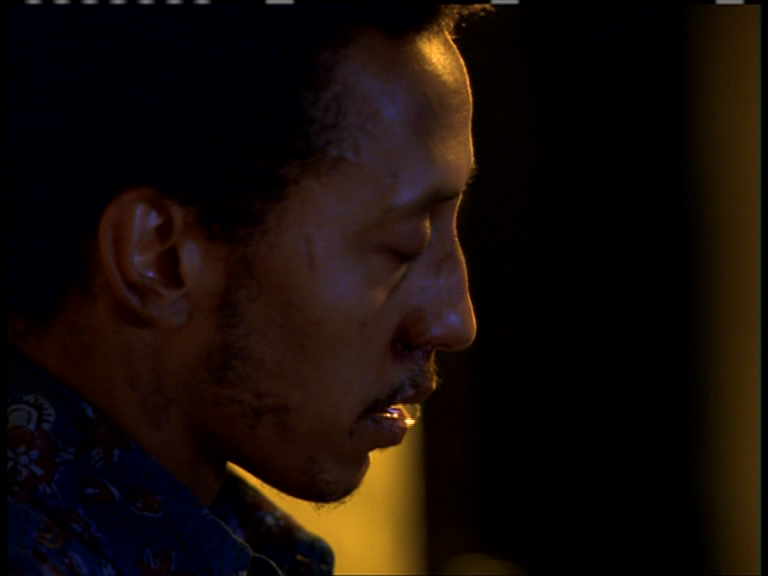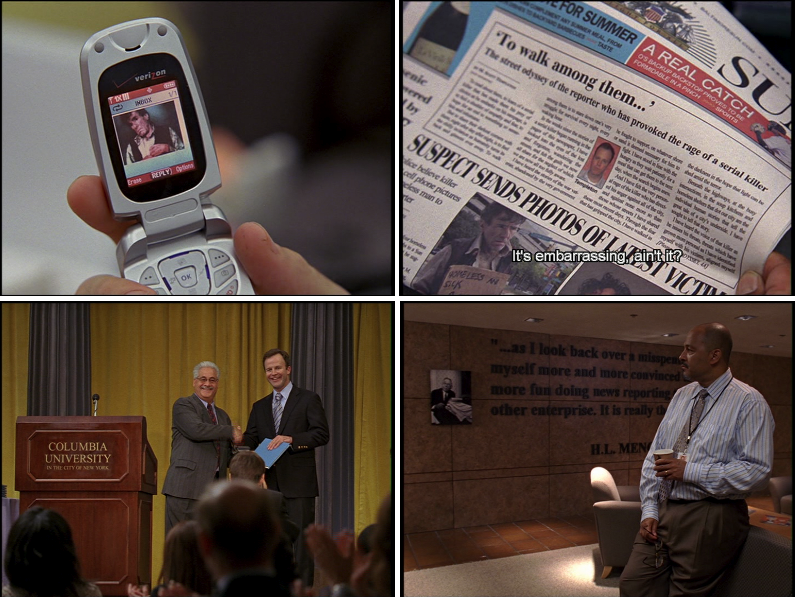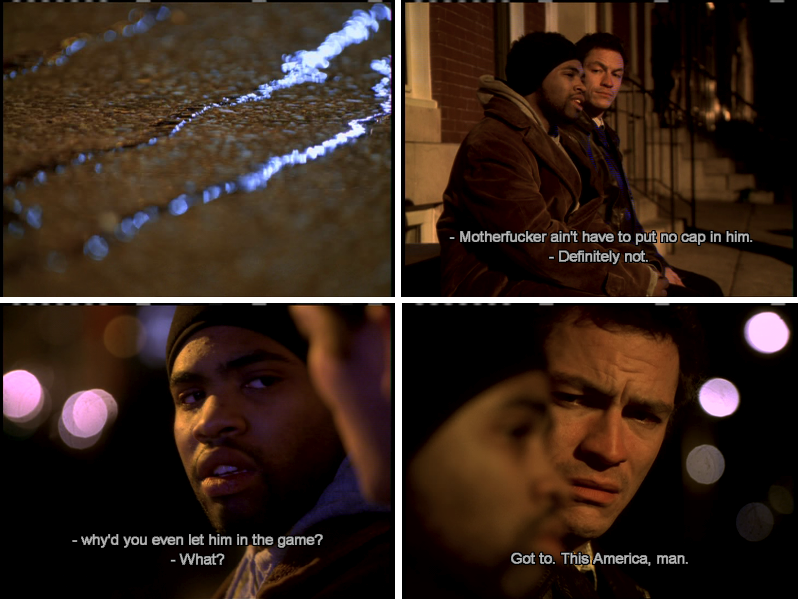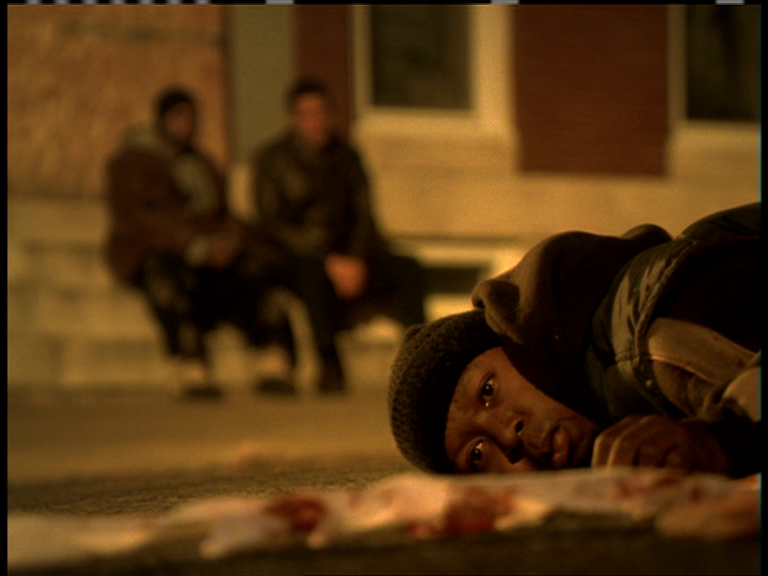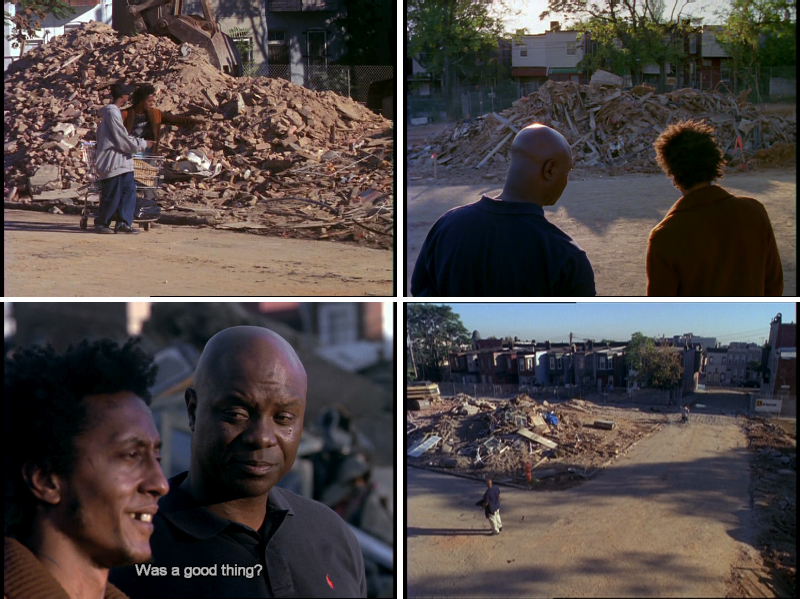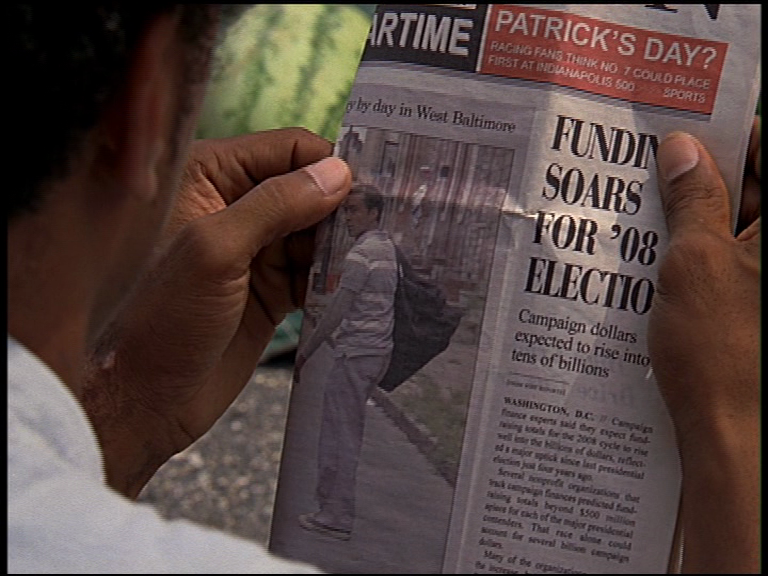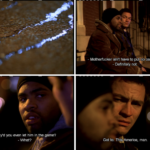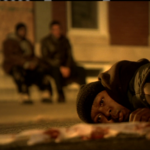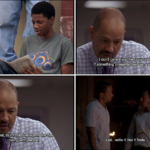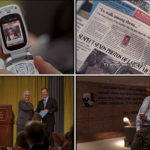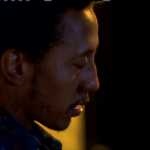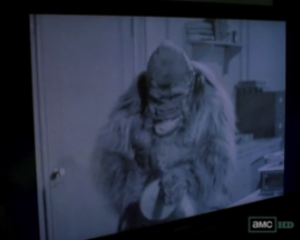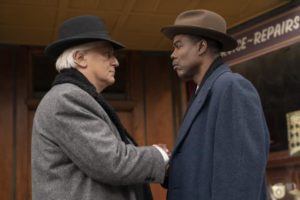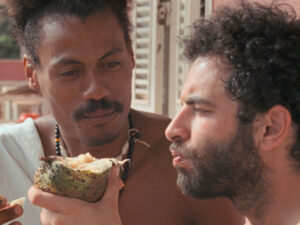The Wire
A Realistic, Modern Serial Melodrama
Many television critics and journalists, not to mention the President of the United States, have cited The Wire as the best television series ever[11][11] In the last minute of a podcast interview conducted by Bill Simmons on March 1, 2012—in an interview otherwise devoted to basketball—President Obama was asked to “settle an office debate” by naming the “Best Wire character of all time.” His answer, “It’s got to be Omar, right? I mean, that guy is unbelievable, right?” was backed up by the statement “And that was one of the best shows of all time.” Bill Simmons, “B.S. Report Transcript: Barack Obama”, The B.S. Report, Grantland, 1 Mar. 2012.. And many of these evaluations extol the serial’s “novelistic” length and complexity. Journalist Joe Klein claims in the DVD features on the final episode that “The Wire should win the Nobel Prize for literature!”[22][22] San Francisco Chronicle television critic Tim Goodman called it “challenging” but a “masterpiece !” Goodman, “Yes, HBO’s ‘Wire’ Is Challenging”. Simon himself calls the work a “visual novel.”[33][33] Indeed, at one point he even goes so far as to compare his achievement to Moby Dick with police procedural substituting for whale procedural. Simon, “Introduction”, in Ralph Alvarez et al, The Wire, truth be told, ed. Alvarez, New York 2004, p.25. Literary critics, such as Walter Benn Michaels, have followed suit. In a lament about the failure of the American novel to tell stories that matter to the neoliberal present, Michaels has claimed that The Wire is the “most serious and ambitious fictional narrative of the twenty-first century.”[44][44] Michaels calls it “the most serious and ambitious fictional narrative of the twenty-first century so far.” Walter Benn Michaels, « Going Boom : The Economic Collapse Points up How Little Our Literay World Has to Say about Social Inequality », bookforum.com (Feb-Mar, 2009). Sociologists such as Julius Wilson argue that it fiction that is sociologically true—by which they mean, it captures the truth their sociology promulgates.
Much of this praise borrows a literary prestige that corresponds to the series’ excellence but not closely enough to its actual serial television cultural form[55][55] Jason Mittell has passionately argued, “television at its best shouldn’t be understood simply as emulating another older and more culturally valued medium. The Wire is a masterpiece of television…and thus should be understood, analyzed, and celebrated on its own medium’s terms.” Mittell, “All in the Game : The Wire, Serial Storytelling, and Procedural Logic”.. In my book ON THE WIRE I argue that before making these more exalted comparisons, we should bring the series back down to earth and see how it grew out of Simon’s journalism at the Baltimore Sun, where he was a somewhat bombastic writer, then out of the conventional melodrama of crime genres and serial television, as an OK writer on Homicide. The Wire IS exceptional, but its exceptionality derives from its roots in contemporary mass culture: in seriality, televisuality and melodrama.
In this talk I will just emphasize this last category: melodrama. When critics say a work is tragic, what they often mean is simply that fates are sad and realistic. To invoke melodrama is to drag along a great many negative clichés: pounding, over-emphatic music, pathetic victims, leering villains, florid acting, and the triumph of virtue in badly motivated happy endings. All of these clichés seem to point to forms of “excess” measured against either more “realistic” or “modern” norms. The Wire is better than any of the clichés, so what is at stake in calling it melodrama?
Most of the negative qualities by which we recognize melodrama are artifacts of the early nineteenth century, when it first became popular, and then again in the early twentieth century when it migrated from the stage to film (Birth of a Nation, D.W. Griffith) and then later to radio and television (Roots, Marvin J. Chomsky, John Erman, Gilbert Moses et David Greene). In film and television study, especially, the resistance to understand the importance of melodrama reflects the belief that something variously called “classical” realism or “classical Hollywood”[66][66] One of the most unexamined premises of film and media studies has been the assumption that, after evolving out of the archaism of a “primitive” early cinema, cinema became “classical” by suppressing the excessive qualities of its obvious inheritance from earlier stage melodrama, which nevertheless survived as a genre of excess. Though I will not delve deeply into this problem here (see instead my recent essay “Tales of Sound and Fury Signifying Something”), I will briefly summarize the dilemma this assumption of a dominant “classical” style of cinema has brought to the understanding of popular film and television. Originally deployed by André Bazin (What Is Cinema? 29-30) as a way of describing a maturity of film art reached in the 1930’s in Hollywood genre films, the idea of the classicality of cinema transvalues, as Miriam Hansen (“Mass Production of the Senses”) has aptly put it, from aspirational maturity to a rather villainous ideological hegemony—in the work of Christian Metz and many others in the 1970s. In 1985 it transvalued again into Bordwell, Thompson and Staiger’s notion of an objectively observed fact: “The principles which Hollywood claims as its own rely on notions of decorum, proportion, formal harmony, respect for tradition, mimesis, self-effacing craftsmanship and cool control of the perceiver’s response—which critics in any medium usually call ‘classical’” (Classical Hollywood Cinema, 3). The classical, in other words, is posited by this theory as the reigning dominant of cinema since 1917 through 1960, but extended by David Bordwell in later work (The Way Hollywood Tells It) into the present. long ago became the dominant form of acceptable filmic and televisual narrative, while a shamefaced melodrama skulked off stage to be consigned to the repressed lower regions of dramatic narrative.
To view melodrama as an archaic excess increasingly banned from a more enlightened and well-motivated classical tradition is wrong in several ways. First, it ignores the modernity of melodrama itself by consigning it to a frozen moment in history—the early period of its emergence in high hyperbole on the nineteenth-century French stage. Second, it views all further developments of melodrama as a shameful atavism rather than as a continuing response to the conditions of modernity. It is to ignore, for example, the ways that newer media like film and television have adapted and reinvented it. Third, it is to assume, as does even melodrama’s great contemporary rehabilitator, Peter Brooks, that by looking hard under the surface of the great works of realist literature—say Balzac—we can discern the embedded remnants of an older melodrama. Even among its rehabilitators melodrama is regarded as an “embedded” “mode of excess.”[77][77] This notion was located prominently in the subtitle of Peter Brooks’ great book, The Melodramatic Imagination: Balzac, Henry James, Melodrama and the Mode of Excess. I believe this too has been a flaw in its theorization.
One has to ask: more excessive than what? At the beginning of the nineteenth century we know what this was: melodrama was excessive in relation to the decorum, unity and efficiency of the high-culture, neo-classical tragedy and the Greek and Roman models that preceded it. This classical tragedy held that characters must declaim their woes with no grand gestures, no startling tableaux, in short, with no “Sturm und Drang”. In relation to ancient or “classical era” tragedy, the new upstart melodrama was radically hyperbolic, the very model of the “bigger-than-life.” Its grand gestures, frozen tableaux, inflated rhetoric and unprecedented use of music was straining to name ineffable that could no longer be named in language due to the loss of a common “sacred.” In film, according to David Bordwell, it is more excessive than the supposed classical realist film.
If the innovation of adding “melos” to drama once shook up and enhanced the emotional power of the melodramatic stage in contrast to the tragic stage, this does not mean that the addition of music today means melodrama and its lack means realism. Rather, melodrama’s conventions have continued to grow and change. Within thirty years of its initial shake up, as Matthew Buckley notes, melodrama had become Exhibit A in the degenerate decline of the drama.”[88][88] Buckley, “Refugee Theatre : Melodrama and Modernity’s Loss”, 176. Not surprisingly, then, many who continued to do melodrama did not call it by name. For the next century and a half melodrama was viewed as a “genre worthy of notice only as the idiotic foil to modern drama’s development of a new, legitimate art.”[99][99] Ibid., 176. Many critics still use the term melodrama as if it adequately described all forms of dramatic manipulation that go too far and which fail to respect certain rules of probability. In so doing these critics have failed to understand melodrama’s ongoing grip on most popular and many high forms of culture as well.
If we are not to fix it at some moment of its previous history then we must appreciate its protean qualities even as we try to isolate some of them for scrutiny[1010][1010] Henry James referred to Uncle Tom’s Cabin—the most influential American melodrama of the nineteenth century—as a “wonderful ‘leaping’ fish” alighting first in one medium and then in another. It had become a more general “state of vision, of feeling and consciousness” rather than a novel, a play, a circus or even an association of songs. See Williams, Playing the Race Card, 13.. Neither excessive music nor the defeat of evil by good is essential to melodrama. What is essential, I contend, following Peter Brooks, Christine Gledhill, Matthew Buckley, Elisabeth Anker, Ben Singer and many others, is the dramatic recognition of good and/or evil and in that recognition at least the hope that justice might be done.
The pathos of the suffering victim turned righteous-action hero is the curious and often suspect alchemy of much conventional contemporary popular melodrama’s cultural power[1111][1111] First Blood (Ted Kotcheff, 1982); Die Hard (John McTiernan, 1988); Air Force One (Wolfgang Petersen, 1997), Avatar (James Cameron, 2009).. To suffer and to be injured is, according to a certain Judeo-Christian framework, to be empowered. We see this in mass entertainment action melodramas just as much as we see it in the stories we tell ourselves about our righteousness as a nation[1212][1212] Williams, Playing the Race Card, 296-310.. Whether it is the oft-told American story of the conquest of the West, or the more recent story of the invasion of Iraq, in our popular melodramatic imagination we either portray ourselves as suffering at the hands of villainous others or, as became more prevalent in American reports towards the end of that war, we are forced to see ourselves as the villains. As long as we can see ourselves as victims, then we seem to morally deserve to conquer and invade—to otherwise occupy the position originally occupied by our injurer. Such is our deeply flawed, melodramatic sense of justice.
So if we only look for contemporary melodrama in its most familiar and clichéd aspects—victims tied to railroad tracks, villains twirling mustaches, rescues that happen too late or in the nick of time, or long-suffering women — then we mistake its contemporary forms. Melodrama makes itself up-to-date by confronting new and seemingly intractable social problems to the melodramatic end of recognizing virtue, or, as I argue in the more ambitious case of The Wire, justice and social good[1313][1313] Christine Gledhill and Thomas Postlewait have both convincingly argued this point. Gledhill writes that melodrama seizes upon the timely social problems of everyday reality. Yet it differs from realism in its will to force the status quo to yields signs of moral legibility within the limits of the “ideologically permissible,” even as it builds upon genuine social concerns (“The Melodramatic Field : An Investigation” in C. Gledhill (ed), Home Is Where the Heart Is: Essays on Melodrama and the Woman’s Film (London: BFI), 1987, 38). Postelwait, for his part, argues against the simple dichotomies: “melodrama distorts, realism reports; melodrama offers escapism, realism offers life; melodrama is conservative, realism is radical; melodrama delivers ideologies….In fact, both melodrama and realism distort and report, conserve and criticize. And both articulate and challenge the ideologies of the time” (“From Melodrama to Realism: The Suspect History of American Drama” in Melodrama: The Cultural Emergence of a Genre, Ed. Michael Hays, Anastasia Nikolopoulou,
St. Martin’s Press, 1996, 56).. Melodrama is the dramatic convention in which timely social problems and controversies are addressed. It is not opposed to what we recognize as realism. Rather, it enlists realism to generate outrage against realities that could and, to its creators should, be changed. Melodrama feeds upon the problem of these realities— the very injustice of them. To this extent, much melodrama is allied with dreams of revolution. But even though melodrama has tended to be on the side of the oppressed, perceptions of justice and injustice will always depend upon where you stand. It might be the injustice of slavery in one melodrama, the injustice of the former slaves in another, the pathetic life of a drug addict and criminal informant in yet another. Melodrama’s commitment to justice is thus not in any way objectively or inherently just[1414][1414] Melodrama is not necessarily for the truly just cause but it is for whomever can be construed as the underdog victim and thus, at least ostensibly it is on the side of the oppressed and powerless. However, the powerless could be slaves in one melodrama, reconstruction era former slave owners in another, Jews in one, the Germans they “infect” in another.”. An audience’s ability to recognize good depends upon the manifest suffering of an oppressed innocence. Only through the sympathy extended to those who suffer can moral legibility occur[1515][1515] See Peter Brooks, who mostly uses the term “moral occult” but sometimes calls it “moral legibility,” a term I find more…legible as long as we recognize that good is not easily made legible in a modern, or what Brooks calls “post-sacred” world. Brooks’ point is that melodrama reaches for the “domain of spiritual forces and imperatives that is not clearly visible within reality” but which operates and “demands to be uncovered, registered, articulated” (Melodramatic Imagination, 21). Thus melodrama is “not only a moralistic drama but the drama of morality: it strives…to ‘prove’ the existence of a moral universe which, though put into question, masked by villainy and perversions of judgment, does exist and can be made to assert its presence and its categorical force among men” (Ibid., 20)..
Melodrama’s pre-occupation with injury thus leads to what have been considered self-righteous and addictive forms of affective conditioning. I have called it the dilemma of vying to be the victim. The most important question I want to address through The Wire is whether melodrama is condemned to repeat these patterns? Is melodrama itself the problem as greater portions of the modern imagination have been given over to its influence ? Or, might it be possible to forge a less self-righteous kind of melodrama, less dependent on wild swings between pathos and action, less a matter of cycles of victimization and retributive violence, and more a matter of reaching beyond personal good or evil to a determination of better justice ?
The melodramatic experience is not a degraded, modern version of tragedy; nor must we think of it as Thomas Elssaeser once did, as the failure of inadequate or “mediocre” humans to play out tragedy. Rather, just as there are great tragedies, there are also great melodramas. And seriality, which I don’t have time to treat fully here, means that no single catastrophe (or “happy end”) need mark its conclusion. But it is through the greater “world and time” of today’s cable television that it may be possible to escape the trap of the self-righteousness of singular personal melodrama.
The Wire has been considered so good, so “realistic,” so “authentic,” that it couldn’t possibly be associated with something so contrived and lowly as melodrama. It has even been disassociated from television altogether (“It’s Not TV, It’s HBO”). Yet if critics were unwilling to call the series melodrama, they often agreed to calling it what David Simon regarded as the same thing: “Dickensian.”[1616][1616] This descriptor that has often been used to point to the novelistic and realistic qualities of the work (see Chaddha and Wilson, “Way Down in the Hole”, 3) and thus interpreted as praise, can also be taken to point to a gripping narrative with a rich array of social types. It is clear, however, both from evidence in the serial and from Simon himself, that it can mean cheap melodrama. See his interview in Vice magazine; see also Klein, “The Dickensian Aspect.”
In the fifth and final season, having heard one too many glowing comparisons of the series to Dickens, Simon created a venal, white, patrician senior editor at the Baltimore Sun, Charles Whiting, Jr. — significantly not from Baltimore — who eventually demotes the responsible and hard working black city editor, Gus Haynes — significantly from Baltimore. The patrician editor also cancels a planned series of (multi-sited) stories on education and instead urges a junior reporter to develop the “Dickensian aspects” of a story about homelessness. This reporter, Scott Templeton — also not from Baltimore — writes a virtuous-victim story about a homeless Iraq War vet suffering from post-traumatic stress disorder. This is exactly the sort of simple victim and villain story David Simon hated telling during his 12 years at the Sun.
His refusal to tell such a story in a series called Metal Men —about men who scavenged metal from vacant houses—cost him his job at the Baltimore Sun. To Simon the scavengers were as much victims as the homeowners who lost their property. He wanted to tell the whole social story of scavengers, police, scrap dealers, drugs, etc—in other words he was already reaching to tell a multi-sited story like The Wire. His editors objected to the complexity and to the fact that one character—Gary, the prototype of Bubbles—was imported from another story Simon was writing and thus was not really there.
Simon’s revenge is thus the patrician editor and the writer Scott Templeton who doesn’t just borrow a social actor from one scene and put him in another, but who makes up his stories out of whole cloth and parlays his Dickensian aspects into a Pulitzer Prize.
Much of the fifth season is devoted to the rise of the lying career of Templeton, developed in parallel to the lies told by Detective Jimmy McNulty about a fake serial killer. McNulty lies in order to channel resources to the police in the ongoing investigation of the new drug kingpin, while Templeton lies out of pure careerism. His venality is contrasted to more diligent and harder working reporters who are demoted as the paper downsizes. We thus see how the entire profession has been cheapened through the “melodramatization” of decontextualized journalism at the expense of facts and deeper context.
Thus does David Simon have his sweet revenge on the bosses who did not appreciate his brand of his more contextualized, “multi-sited” journalism. But thus also s did Simon melodramatically vilify his former bosses not only by showing to what lengths they will go to win Pulitzers, but also by showing how his own contextualized “multi-sited” institutional reporting—what The Wire teaches about Baltimore by resorting to fact based fiction—goes deeper and farther. Of course the irony is that Simon deploys conventions of “old fashioned” melodrama—uncomplicated victims and villains—in order to condemn the Dickensian project of telling stories with overdrawn victims and villains !
In the fifth season of The Wire, more than in any other, we are invited to hiss the patrician villains and root for the downtrodden city editor. What Simon really objects to in the epithet “Dickensian” is not the pathos of virtuous suffering but the happy ending that produces moral legibility too easily as in the triumph of virtue that occurs simply because of a personal change of heart. The “nice old uncle” or guardian who comes along in the end to “fix things” is Simon’s true objection to Dickens[1717][1717] Simon admits that Dickens was a great writer who “exposed the fault lines of industrial England…where money and power route themselves away from the poor.” However, he abhors the fact that “In the end, the guy [Dickens] would punk out… The Wire was actually making a different argument than Dickens, and the comparison, while flattering, sort of fell badly on us.” The invocation of “Dickensian” was “a little bit of tongue-in-cheek satire on the show directed at people who were using Dickens to praise us.” But he adds a more personal motive: “When I was coming back off of the reporting for The Corner and preparing to go back to the newspaper, this editor and I talked about writing columns about life on the streets in West Baltimore. That, to me, would have been the narrative equivalent of telling some stories that you ultimately saw on The Wire, but using real people. The first one that I tried to tell…he spiked. It was about a guy very much like The Wire character Bubbles who was harvesting metal—two guys harvesting metal, actually.….He came to me and said, ‘I want to do the stories that are about the Dickensian lives of children growing up in West Baltimore.’ What he was saying was, ‘If you give me a nice, cute eight-, nine-year-old kid who doesn’t have a pencil, who doesn’t have a schoolbook, who lives in poverty, who’s big eyed and sweet and who I can make the reader fall in love with, I can win a fuckin’ prize with that. Write me that shit…..Don’t give me a guy who’s, like, trying to get high but maintain his dignity. Don’t give me anything complicated.’ And he really used the word ‘Dickensian’” (Interview, Vice)..
The Wire, even in its fifth and most overtly melodramatic season, shows us a way out of the impasse of the nineteenth-century Dickensian melodrama and its inability to reach beyond the good of individuals by playing out the quest for moral legibility at both the personal and the institutional level. In this way it also corrects the Dickensian tendency to privilege the merely temporarily disadvantaged who always turn out, in the end, to be well born and thus deserving. This is its key difference from ordinary melodrama. Ultimately, The Wire is about individuals grappling with unwieldy institutions who, at best, may claim small victories. It is thus a matter of great concern whether the police can do more than merely catch bodies or make drug rips, or whether the unions can avoid corruption, or whether the city government can decide whether it is police or schools who need what limited funds are available, or whether schools can enable teachers to really teach, or whether media can report the truth of what happens in the city. This is where the “procedural” element of the series, modeled on the police procedural but extending to these other institutions of the city, engineers a better form of melodrama.
The Wire is a police procedural not simply in its observance of the routines of questioning witnesses or gathering evidence, but also in its focus on the moral life of police as an institution. By the fifth season when Detective Jimmy McNulty fabricates an attention-getting serial killer in order to receive funding to pursue the real crimes of Marlo Stanfield, and when Lester Freamon follows him down this path, we know that these lies are no more a product of being “good police” than Scott Templeton’s fabricated stories are a product of good reporting. In order to solve the case of the many dead bodies walled up in the vacant houses, McNulty invents evidence of a serial killer whose sensational crimes as reported by the Sun bring them the overtime and vehicles to work the real case of the bodies found in vacant houses that no one cares about. At this point, both the institution of police and the institution of journalism have failed the moral test. While there are still good police on the force who refuse to go along with this scheme—especially Kima Greggs and Bunk Moreland—and while there are still good reporters on the beat—especially Mike Fletcher and Alma Gutierrez—the institutions as a whole have failed to perform their most basic functions.
When David Simon insists that The Wire is neither a “cop” nor a “crime” show, he associates more simple melodramatic genres with the overarching mode of melodrama as a battle between good and evil: “We are bored with good and evil,” he writes. “We renounce the theme.”[1818][1818] Alvarez, The Wire : Truth Be Told, 4. I argue that he has not renounced it. Rather he has transmuted it to a new level of investigation. And the voice in which Simon renounces these recognizably generic forms of melodrama is the same one with which Simon once wrote op-ed style journalism on the failure of justice in the modern city as a reporter for the Baltimore Sun — a royal “we” that speaks resonantly on behalf of society’s victims but that fails to convey that its voice is also of them. This is the voice of (yesterday’s bad) melodrama, speaking bombastically and self-righteously as a contemporary “J’accuse.” This is the voice that Simon fortunately lost when he learned to dramatize, rather than editorialize, on behalf of society’s victims and against its villains in writing for serial television. But the very fact that he found a way to suppress the overt righteousness of his own (archaic) melodramatic voice should not blind us to the (better) melodrama of the work created in its stead.
The police procedural frames the series as a whole, most famously in the cold open of the very first episode of the first season. As in thousands of homicide shows, a cop interrogates a witness over a dead body. What is different here is that solving this murder will not enlighten us about anything. Rather, what matters here is the reference to America and a freedom of opportunity that turns out to only be the freedom to commit a crime. Thematically this police procedure opens us up to the whole serial investigation of the institution of criminals who have their procedures as well. We come to know cops and robbers both. In the second season, cops and dealers are kept in play as an earnest but corrupt union leader tries to revive the American dream. In the third season city government and the possibilities of reform come into play, among police, drug dealers and a reform minded mayoral candidate Dramatizing both the necessity for, and the difficulty of, reform within each of the major institutions portrayed, The Wire’s melodrama operates at both the personal and the institutional level. It is the meshing of the individual and the institutional that allows it to picture the political and social totality of what ails contemporary urban America and imagines what justice could be. No other television series or film “franchise” has accomplished this feat.
The procedures of one institution impinge on another, each providing a full fabric of moral contexts, each context influencing another. For example, in season 5, because the newly elected Mayor Thomas Carcetti’s ambition to run for governor had caused him to refuse to accept a handout for education from the current Republican governor, he finds himself without enough funds for both police and schools. He chooses not to fund the police and thus orders them to curtail the investigation into the bodies found in the vacant houses. This precipitates Detective Jimmy McNulty’s decision to fake evidence of a serial killing by breaking the neck of an already dead homeless man to match the m.o. of a corpse he recently viewed in the morgue. With such a sensational crime, McNulty correctly figures, resources will flow again to the Major Crimes unit. Something like the same reasoning is employed by Scott Templeton as the Baltimore Sun downsizes and reporters, like police, are asked to do “more with less.”
In this way, The Wire recalibrates the very meaning of the melodramatic recognition of virtue to an institutional as well as a personal level: the institution of the police either can or cannot recognize the “good” of effective community policing (the point at which McNulty fabricates false evidence and begins giving out overtime, they can’t); the institution of drug dealers either can or cannot recognize the good of avoiding the casualties of “dropping bodies” (the point at which Marlo Stanfield begins to kill for the slightest provocation proves that they can’t); the unions either can or cannot provide work without engaging in corruption (the point at which Sobotka’s nephew and son take his cue and do their own illegal smuggling, proves that they can’t); the city government, either can or cannot recognize the good of real reform, not just the appearance of it (the point at which Carcetti chooses his own career over money for schools, proves that it can’t); the schools themselves either can or cannot recognize the good of teaching and learning with the benefit of “soft eyes.”[1919][1919] Soft eyes are a way of teaching and detecting that can take in the whole scene without looking hard at any one thing and that can intuit the whole. And the city newspaper either can or cannot recognize the good of truthful, scrupulous reporting (at the point at which Templeton is praised within the paper for his fabricated stories and purple prose, it is clear it cannot).
The fact that in the end, none of these institutions can recognize what is just and good in its own operation, despite the many individuals who try, is the basis of the series’ famous anger and “dissent.” But except for Sobotka and Bell, these failures do not form the basis of individual tragedy. In the end we find a city that remains in the grip of self-serving, short-sighted careerist police, ever-more ruthless gangsters, a corrupt city government that will always “disappoint,” schools where the best an individual teacher can do is control a class and encourage a kid or two, and a media that misses most of the important stories that the multi-sited ethnographic imaginary of The Wire has already told. But the point of this melodrama is not simply to despise the villain and root for the good person, but to understand how the individual and the institution mesh. In the fifth season, for example, we come away understanding that Marlo Stanfied is a more perfected version of Stringer Bell. We see it in the coldness of his gaze and single-minded devotion to the drug trade. It is the institution that has made him. This added institutional level of melodrama is the most bravura achievement of The Wire. It is the day-to-day workings of these institutions—at the nitty-gritty level of budgets, drug profits, political horse-trading, and editorial practices, all cross cut for maximum interaction and comparison—not private loves, kindly uncles, or personal villains—that determine fates.
In order to fully appreciate the institutional nature of this serial melodrama, let us consider the way it plays out in relation to the most overtly Dickensian character in the whole series : Reginald (“Bubbles”) Cousins.
Bubbles, derived from Simon’s original story on Metal Men, is Dickensian in the way of the more colorful and eccentric characters. As a drug addict, he is a regular fixture of the corners; as a criminal informant, he is also familiar with, and to, the police. Indeed, he is crucial to the very ability of the series to connect its many different worlds. The novelist Nick Hornby likened “the hapless Bubbles, forever dragging behind him his shopping trolley full of stolen goods” to “Joe [sic] the Crossing Sweeper” in Dickens’ Bleak House. Jo makes his living by sweeping a path through the filthiest intersections for fastidious upper-class pedestrians to pass. Despite the fact that Jo is an adolescent boy and Bubbles a mature man, it is easy to understand why Hornby emphasizes their similarities. Both are peripatetic figures of the street who arouse sympathy. Bubbles’ shopping cart is like Jo’s broom, a tool that enables bare survival from a street that only wants both of them, as the constable repeatedly urges Jo, “to move on.”[2020][2020] Dickens, chapter 19, 168.
However, the differences between Jo and Bubbles also reveal the ways in which The Wire diverges from the model of Dickensian melodrama. Jo is Dickens’ trump card in his plea for parliamentary reforms to address the suffering of indigent Londoners. But as a trump card he has a limited role to play beyond generating pity. His job is to die because he is really too poor and benighted to be redeemed the way the truly worthy Dickens characters like Esther in Bleak House, or Oliver Twist, whose rightful place in an ascending bourgeois order must be established. Jo is a character who can neither grow nor change, not even over a six-hundred-page novel in twenty originally serialized parts.
Bubbles might initially seem Dickensian in this same way—as the poor but good-hearted vagrant-addict with no proper place in society. As it turns out, however, if Bubbles is hapless, he is hardly benighted. Indeed, his memory of names, streets, and license plates makes him an invaluable source of information. He is also an irrepressible teacher and mentor to his younger partners in crime, always trying to “school them” with his knowledge of how to make a buck off the detritus of the streets. In season 3 Bubbles escalates his economic activities from scavenging to commodity capital as he invests in goods to fill his shopping cart, selling used cell phones and tee shirts to the inhabitants of Hamsterdam; later, he stocks up on condoms, toilet paper and hoodies. When Hamsterdam is reduced to rubble it is Bubbles who is called upon to pronounce upon it.
I’d like to show this scene because it seems to me to be the essence of melodrama’s important recognition of virtue. It is the end of the third season the police major Bunny Colvin has been fired. His experiment of creating the drug-zone of Hamsterdam, has enabled many of the other neighborhoods in his district to resume normal life. Hamsterdam has been a brave experiment, proving that a de-facto legalization of drugs can reduce crime, but the police and the Mayor’s office shut it down. This is an obviously sad ending. But in the final scene of the final season we have this coincidental meeting of two individuals—the drug fiend Bubbles and Major Colvin, now fired and out of uniform. It begins with Bubbles scavenging metal through the bulldozed ruins of the old drug zone until he comes across the defeated Colvin.
This is one of those wonderful Dickensian coincidences when two characters we have come to love and admire, from different social strata, run into and understand one another. It is underplayed certainly. Colvin’s great experiment has failed and he has lost his job. He does not stand on the stage to utter his pain. But Colvin asks if Hamsterdam was “a good thing.” Bubbles does not easily perform the requisite recognition of virtue. Unsure to whom he is speaking, he backpedals and retreats, but as he leaves, and if by the third season you have learned the speech patterns well enough, you understand that when he walks away, Bubbles gives his assent. “you probably don’t know, but its rough out there baby; cops be banging on you; hoppers be messing with you….” In other words, and not in so many words, it was a good thing.
Yet Bubbles shows his own pathos in this scene. We have known Bubbles since the first season and have come to know the scavenging and pedagogical routines of his life—including the favorite lesson to a new protégé about thinking one is brown (cool) when one is really green (inexperienced)—and we know the repetitions in which Bubbles is caught. His own pathos is as evident as Colvin’s. However briefly, and without really knowing it, each recognizes the good in the other.
This recognition of virtue is understated and it is spoken in the realistic language of the street. But as the crane up and back signals in a rare flourish, and as we hear the extremely rare melos of the music that marks the end of an episodic, and in this case the end of a season we have just seen the one person in the series qualified to pronounce upon the “good” that was once Hamsterdam and thus the good that is ex-Major Colvin. The moral legibility of melodrama is served at this midpoint of the entire serial.
By the fourth season Bubbles will have two shopping carts and an assistant. And by season 5 he will be clean, though still on the street, selling The Baltimore Sun. Indeed, except for the fact that his motive until the fifth season is to feed his habit, Bubbles is the very model of homo economicus, making rational decisions about his profit margin, asking nothing and getting nothing from the dwindling welfare state.
In the fourth season, however, Bubbles’ unintentionally causes the death of Sherrod, his latest partner and protégé. Devastated, the usually irrepressible Bubbles turns himself in to the police for murder and tries to hang himself in the interrogation room. A homicide sergeant pulls him down from his noose and has the decency to send him where he actually needs to go: not to trial and jail (and a much-desired closed case) but to a psychiatric unit where he will get clean and make good use of his Narcotics Anonymous sponsor.
The Wire thus dramatically makes the case for the need for state-sponsored care and thus against neoliberal ideology—though without the self-righteous editorializing of Simon’s earlier journalism. Indeed, Bubbles’ many trials richly illustrate, despite all his industry, the failure of the neoliberal ethic of self-sufficiency[2121][2121] Neoliberalism can be briefly defined as a “theory of political economic practices that proposes that human well-being can best be advanced by liberating individual entrepreneurial freedoms and skills within an institutional framework characterized by strong private property rights, free markets, and free trade. The role of the state is to create and preserve an institutional framework appropriate to such practices” (David Harvey, A Brief History of Neoliberalism, 2). Harvey’s succinct book traces the emergence of this ideology in the late 1970’s as deregulation and the withdrawal of the state—in China, the United States and Britain—from the role of social provider has left an ideology that “seeks to bring all human action into the domain of the market” (2-3). Neoliberalism holds, counter to much evidence to the contrary, that “social good will be maximized by maximizing the reach and frequency of market transactions” (3). The underlying argument of this chapter is that as neoliberalism has transmuted to a self-evident “common sense,” it has become the role of a new kind of melodrama to counter these assumptions by revealing not only their human but their larger institutional cost.. This unintentional and highly melodramatic murder shatters him, leaving him a twitching mass of grief and guilt.
Though Bubbles does get clean in the state-sponsored psychiatric unit, it is not this care that fully “fixes” him. It merely puts him in the clean and sober place where he can eventually publically forgive himself for the death of his friend Sherrod in the approved N.A. manner. At this point the series seems perilously close to deploying an entirely Dickensian Christian compassion as his rescue (5.9 “Late Editions”).
Fortunately, however, The Wire has a bigger redemption in mind—not only the personal redemption of Bubbles but the institutional redemption of the amply vilified news media. Indeed, it is at the point that these two redemptions come together that the series seems to believe that a happy ending has been adequately earned. To be sure, it is a highly qualified happy ending and it certainly does not redeem the entire news media as much as it redeems Bubbles. But what it leaves us with is the hope that justice can, at least sometimes, be done. In this case, the fact that the news media manages to tell one “true” story, serves as a counter force to all the lies of the Pulitzer-hungry Scott Templeton and his editors.
As Templeton’s star rises at the Sun and as city editor Gus Haynes loses clout, Haynes nevertheless continues to do his job by encouraging a young news writer Mike Fletcher to test his wings. Because manipulated publicity has now shifted to the plight of the homeless, Fletcher is now writing about that. But he recognizes and articulates the flaws of such writing: “…formula…anecdotal lead….” Haynes agrees with this criticism but encourages him to dig deeper. “Spend some time with these people. Sometimes the weakest shit in a story is the stuff with quotation marks around it. You got a guy telling us how rough it is on the street…That doesn’t have much pull; but if you can describe how it really is, tell his story in moments… I’m not interested in great quotes, I’m interested in what feels true” (5.7 “Took”).
At the same time that Scott Templeton is generating bogus quotes from the homeless and a phone interview with a serial killer whom he thinks is authentic (perfectly enacted by Jimmy McNulty), Haynes tells Fletcher to write what “feels true.” In search of this truth, Fletcher finds a guide to this world in the person of Bubbles, who is at this point volunteering in a soup kitchen and selling the Baltimore Sun on the street. Bubbles acts as Fletcher’s guide to a homeless encampment under the freeway and, encouraged again by Haynes, Fletcher decides to write about Bubbles even though he is not at this point homeless himself. Compared to the “rifle shots” of Templeton, Fletcher’s journalism—the very model of Simon’s contextual reporting at the Sun — does indeed take time to build context. However, in the same breath that Haynes grants Fletcher a couple of weeks to write about Bubbles he chooses to run a story about a fire rather than a story about a thirty-four-year-old black man killed in a convenience store by a juvenile, thus missing the “other” most popular personal story in The Wire—that of Omar Little. The Sun—even when its “good” editor calls the shots—still misses a lot.
Though we never read what Fletcher writes about Bubbles, we get snatches of it as Bubbles shows the manuscript to Walon, his N.A. sponsor, asking if he should let it be published. Walon does not directly advise, but his judgment about the writing would certainly please Haynes, for to Walon, “it feels true…he’s got you….He ain’t lettin’ you off the hook for shit; he’s just putting it all out there: the good, the bad….” But here Bubbles interrupts. He doesn’t mind the bad, but he does suspect the good. “You skeered of somebody callin’ you good?” asks Walon, finally getting Bubbles’ number. Bubbles correctly observes that what he is doing is not special. Why should he get special moral credit for simply not getting high? Walon’s answer is worth considering since it is ultimately an answer to the question of the moral value of melodrama itself. He brings out a well-worn quotation passed on to him from an N.A. meeting and Bubbles reads it aloud: “You can hold back from the suffering of the world and you are free to do so for it is in accordance with your nature. But perhaps this holding back is the one suffering you could have avoided” (5.10 “30”). In other words, suffering itself is good and is here so recognized by a writer whom Bubbles calls “Franzie Kafka.”
In the end, Bubbles allows the profile to run. It is a feature entitled “The Road Home” on the front page of the Sun, with a caption that reads “A life at the margins is reclaimed day-by-day in West Baltimore” and a picture of the cleaned up Bubbles beneath. Bubbles reads, ponders and seems to approve. He has both allowed his suffering to be recognized and at the same time he has questioned its automatic moral value, perhaps the best that can be asked of melodrama’s always dubious transformation of suffering into virtue. He stands up, puts on dark glasses, and picks up two plastic bags apparently full of food. This is the first time we see him in the role of a consumer (of anything but dope) instead of a scavenger or vendor, a sign of his new maturity and citizenship and imminent admission into the upstairs world of his sister and her family. We immediately miss the old Bubbles, for there is no question that once his suffering ends, once his virtue is recognized in conjunction with that of the only minimally redeemed institution that publishes it, he ceases to be of much interest. His story, and the multi-institutional, multi-sited one of the serial itself, is over.
This story about Bubbles is The Wire’s fictional stand-in for the story about metal men that David Simon claims was “spiked” by editors, but did in fact run. Its “publication” here is a thoroughly (self-)righteous vindication of Simon’s brand of journalism. It is simultaneously a repudiation of Templeton’s “rifle shot” that “surround[s] a simple outrage” in favor of the journalism that takes time for context and which must “feel true.” So on first sight it might seem that The Wire is guilty of doing what Simon most abhors in the whole panoply of Dickensian tricks: the recognition of virtue through suffering leading to a happy end in which Bubbles finally is admitted to the upper regions of his sister’s family and home. Does this mean that The Wire has gone all soft and Dickensian on us? Is this ending perhaps even more Dickensian than Dickens? Certainly, if we simply measure these two works by the standards of the usual clichés about melodrama, it would seem that in the case of street-level virtuous victims, Simon is even more melodramatic than Dickens. For the fact of Jo’s death—if not the manner of it—is “realistic,” while Bubbles’ rescue from abjection could be considered less so. It is, moreover, a rescue that has needed to be repeated many times over before it actually works[2222][2222] It represents the combined efforts of Jay Landsman, the state’s psychiatric clinic, Walon’s volunteer work as Bubbles N.A. sponsor, the young reporter Mike Fletcher and Gus Haynes, Fletcher’s mentor at the Baltimore Sun.. To say this, however, would be to fail to understand the key quality of melodrama and the very reason for the existence of the form. For as we have seen, melodrama is not that which opposes realism but that which becomes more modern and relevant by incorporating realism’s outward manifestations.
Signs of realism in melodrama are always in the service of the recognition of virtue or of its opposite, villainy. This is the case for both Jo and Bubbles, given the different standards of realism of each time.
In The Wire young boys are dying just as pathetically as Jo and usually from causes more violent than Joe’s starvation and smallpox. And there is indeed pity generated for their suffering. The hard-earned redemption of Bubbles teaches us that if there is to be a hope for justice, as there must be in melodrama, it must be through an alignment of many complex institutional and personal pieces. The good that Bubbles ultimately recognizes in his own suffering is earned. And it is earned not only by Bubbles but by a practice of journalism that lends an aura of justice to the story told about him.
We should make no mistake: a sense of justice is no substitute for actual justice. But it is the aspiration for justice that is melodrama’s own, most important, virtue no matter how often it is perverted. What melodrama can offer at its best is thus something that tragedy cannot supply. In The Wire it is ultimately a vision of a better govermentality, “an alternative vision of the good…a vision in which justice would not center upon maximizing individual wealth or rights but on developing the capacity of citizens to share power and collaboratively govern themselves.”[2323][2323] Brown, “Neoliberalism and the End
of Liberal Democracy”, 41. This is the good gained when Bubbles ceases to be a victim and becomes instead what both the police and the outlaw Omar call a “citizen.”[2424][2424] Citizen is The Wire’s term for a person not involved in crime. When Brown argues the need for a “different figuration of human beings, citizenship, economic life and the political—to fashion a more just future,” I can’t help but think that that figuration has in fact been achieved, not in a utopian picture of achieved fairness, not in a bleak tragedy of the triumph of injustice, but in the mixture of melodrama, and occasional glimpses of more tragic fates of Sobotka and Bell, that is The Wire.
The alternative to Dickensian melodrama is thus not the bleak austerity of Greek tragedy. But neither is it the case that whenever the series grants a happy ending to a particular individual that it betrays its principles. Most important to the new type of melodrama that The Wire forges are the opportunities offered by the serial’s multiplication of worlds and their interaction over time[2525][2525] See Williams, “Mega-Melodrama ! : Vertical and Horizontal Suspensions of the ‘Classical”, Modern Drama 55 (4), University of Toronto Press, 523-543... This sensibility of both “world and time” is what cannot be achieved even in a long movie for it only happens with repetition over time, when the rhythm of certain situations is felt again and again.
Conclusion
If we can agree that melodrama endures not only as an archaic holdover of the nineteenth century stage play (and its virtuous victims and leering villains), not only as women’s films or chick flicks or Oprah confession, and not only in soap operas and disease-of-the-week TV movies, and not only as the genre of family melodrama not only as action and spectacle, but as an evolving mode of storytelling crucial to the establishment of moral good—or as David Simon would put it: justice—then we might be able to see not only how melodrama endures in The Wire but how it evolves towards the presentation of a higher sense of justice, beyond the generation of mere pity.
We tend to forgive melodrama for being melodramatic if it seems “realistic” and if its politics, or sense of justice, coincides with our own. We like melodramas in which the good we believe in is recognized. The undeniable innovation of The Wire is its effort to tell a melodramatic story at the level of the social institutions that have themselves repeatedly failed to serve justice. Seriality enables a new energy and means for the frustration of that justice if the aspirations for liberal democracy are still valid in the era of neoliberalism, and if tragedy cannot stoop to care about the truly powerless, a newly evolved serial melodrama proves to be the primary tool with which mass culture makes the case for some kind of justice.
We should neither laud The Wire as exceptional tragedy nor identify it as conventional melodrama. Rather we should appreciate its deeply felt contemporary reinvention of the mode of melodrama. This mode, as we have seen in the last two chapters is made possible by a serial melodrama in tension with the work’s self-conscious effort to be tragedy and its overidding quest to recognize a good that is no longer self-evident in a neoliberal era. If melodrama, as Peter Brooks has argued, is a central poetics of modern life and inextricable from popular media, it should be part of our critical vocabulary not only so that we can complain about it when its older qualities persist but so we can appreciate it, as is the case with The Wire, when it evolves into something new. The mode of melodrama still holds us in its grip. We should recognize it, even (or especially) when it is “good.”
***
Lecteurs et lectrices fidèles ou infidèles,
Débordements a le grand plaisir de vous annoncer la parution de son premier numéro papier. Celui-ci est en grande partie consacré au travail de David Simon. Pour en savoir plus, nous vous renvoyons à notre page de commande.
Toutes les images proviennent de The Wire.
